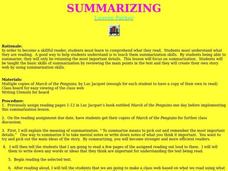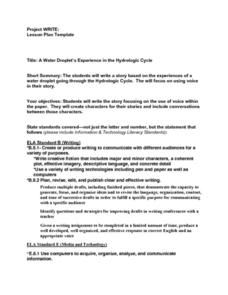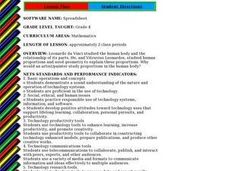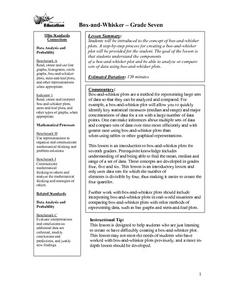Curated OER
Instant Spelling Activity: Homophones
Second graders explore the concept of homophones. In this spelling skills lesson, 2nd graders discover the definition of homophones and practice identifying homophones. Extension activities suggested are included with this lesson.
Curated OER
Proofreading - Spelling, Capitalization, Grammar and Punctuation
Fourth graders practice proofreading a passage. In this proofreading lesson, 4th graders complete a worksheet by reading a passage and circling twelve errors. They proofread for errors in spelling, capitalization, grammar, and punctuation.
Curated OER
Assuming Responsibility
Sixth graders explore the concept of responsibility. In this character education instructional activity, 6th graders discuss the various types of responsibilities they have. Students create their own definition of responsibility based on...
Curated OER
Summarizing
Third graders examine how to summarize the most important details in a reading passage in order to increase their comprehension. They design a story web using the summarization skills. Before class, they complete a reading assignment...
Curated OER
Bunnicula
Students create a dictionary of vocabulary after reading a story. Individually, they create a story web making sure to include all of the basic story elements. They also create a timeline and write a book report of all important events.
Curated OER
A Water Droplet's Experience in the Hydrologic Cycle
Students write a story from the perspective of a water droplet on a journey through the water cycle. They use the 6+1 Traits writing method to focus on voice in the writing as they create characters that their water droplet has...
Curated OER
Welcome to Venice
Learners read the opening scene of the play, The Merchant of Venice without receiving any background information. They analyze and discuss the relationships between the six characters, and determine the social status of the characters.
Curated OER
Manners Matter
Young scholars demonstrate proper behavior in the classroom and in other social situations. They write journal entries, create posters, invitations, and or multimedia presentations depiciting good manners. Pupils pair up with another...
Curated OER
Beyond Louisiana
Eleventh graders examine the challenges that faced United States as a new nation. In this American History lesson, 11th graders study the chronology of events leading up to the expedition of Lewis and Clark. Students organize...
Curated OER
Could You Repeat That?
Students participate in an oral story telling activity designed to show how story embellishments occur. They read "Beowulf" and identify incongruities that suggest additions and embellishments over the years.
Curated OER
The Underground Railroad in the I and M Canal Area
Students discuss provocative statements about the Underground Railroad and form opinions. They locate and read a selection on the Internet that either supports of discredits their written opinions. They then read a speech by John Hossack.
Curated OER
Body Proportion
Fourth graders measure the height and arm span of various classmates. They use a spreadsheet to design a graph that shows the class measurements from tallest to shortest in metric and standard systems.
Curated OER
Let's Take a Trip!
Sixth graders plan trip for family of four, and choose best travel plan by studying maps, considering different routes, and visiting Web sites to get airline and travel schedules.
Curated OER
Linear Patterns in Data
Eighth graders extend their learning of graphing linear equations and are introduced to connecting patterns in tables and graphs to represent algebraic representations. They then determine patterns and extrapolate information from these...
Curated OER
Box-and-Whisker
Seventh graders are introduced to the concept of box-and-whisker plots. A step-by-step process for creating a box-and-whisker plot is provided. The goal of the lesson is that students study the components of a box-and-whisker plot and be...
Curated OER
Discovering the Local Community
Third graders create a mini-atlas of the human and physical characteristics of their local community, which includes landforms, climate, vegetation, population, and economics. They use nonfiction map-related resources to obtain ...

















